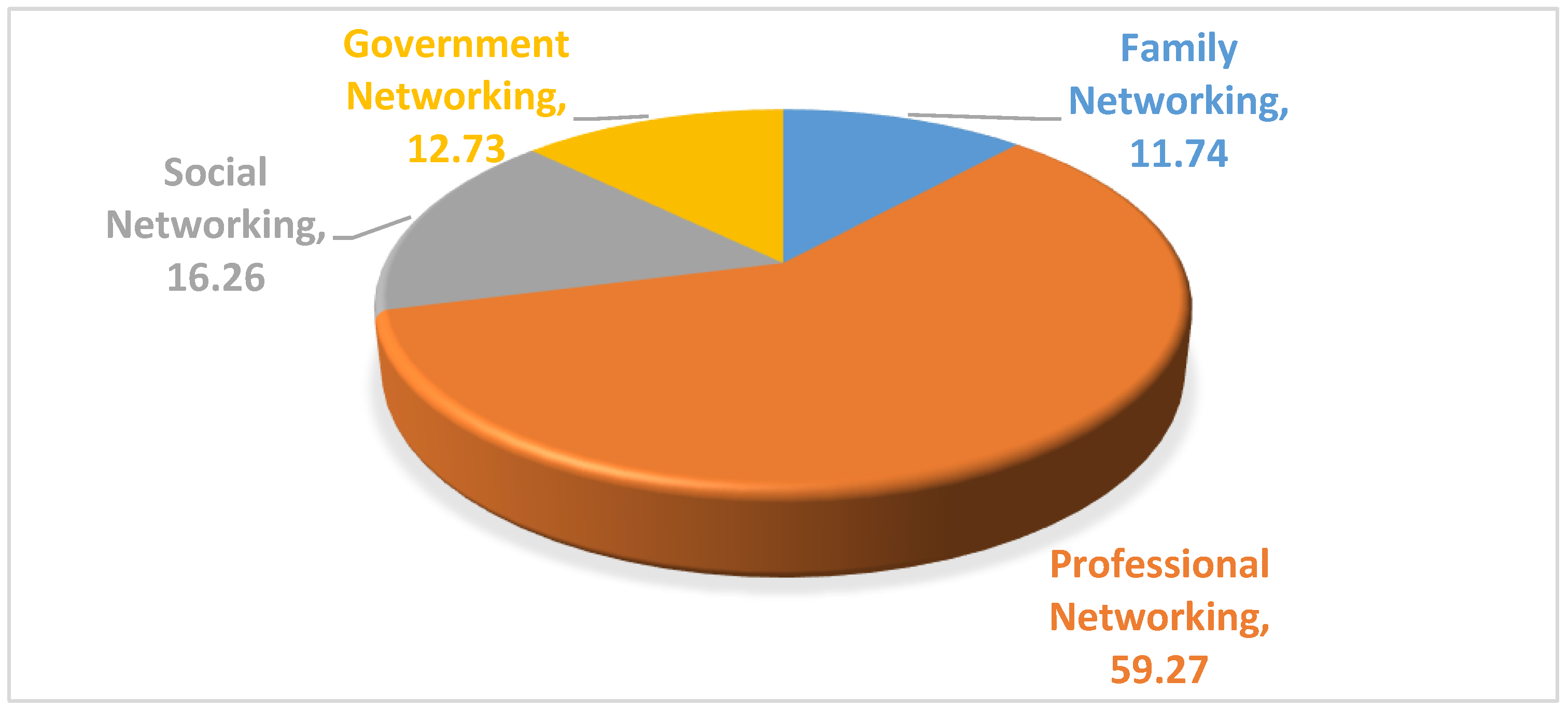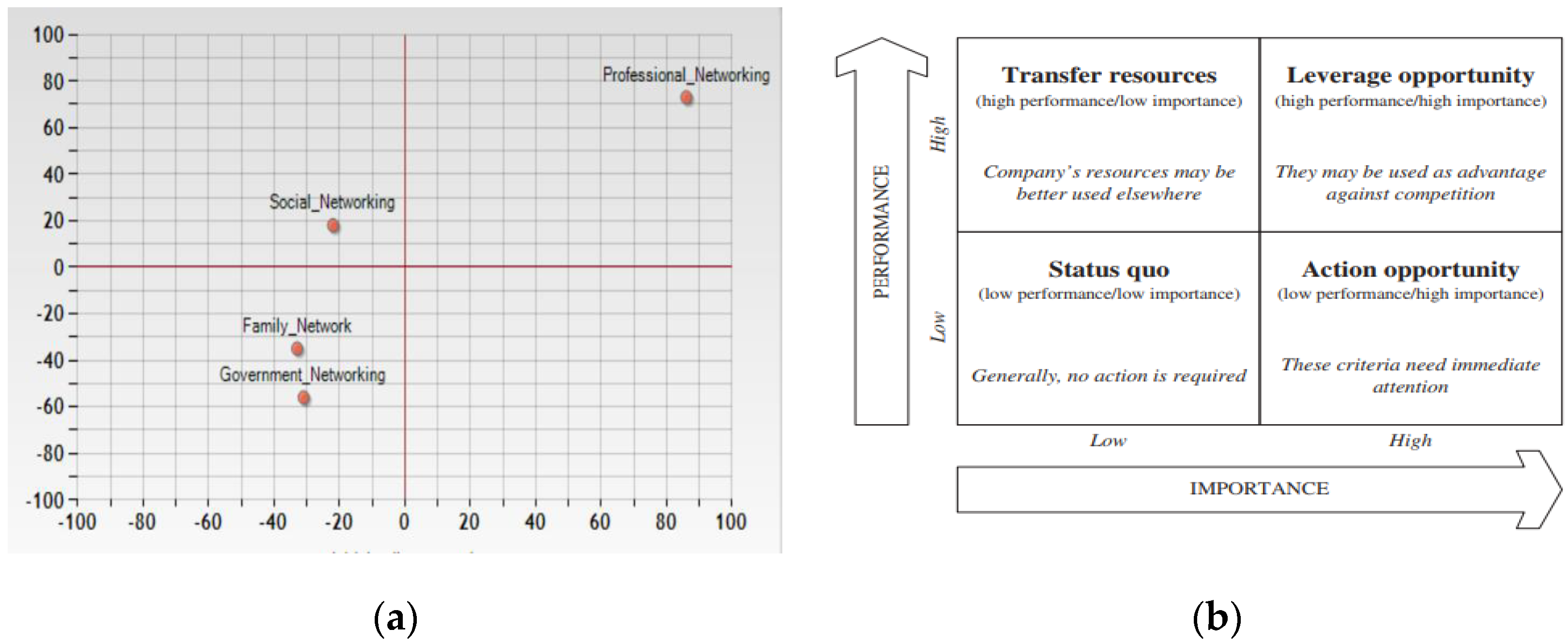Data on Creative Industries Ventures’ Performance Influenced by Four Networking Types: Designing Strategies for a Sample of Female Entrepreneurs with the Use of Multiple Criteria Analysis
Abstract
:1. Summary
2. Data Description
3. Methods
3.1. The Multicriteria Creative Industries Evaluation Method
3.2. Results
4. Conclusions
Supplementary Materials
Author Contributions
Funding
Acknowledgments
Conflicts of Interest
References
- Csikszentmihalyi, M. The creative personality. Psychol. Today 1996, 29, 36–40. [Google Scholar]
- Matheson, B. A culture of creativity: Design education and the creative industries. J. Managem. Dev. 2006, 25, 55–64. [Google Scholar] [CrossRef]
- Bridgstock, R. Not a dirty word: Arts entrepreneurship and higher education. Arts Human. H. Ed. 2013, 12, 122–137. [Google Scholar] [CrossRef] [Green Version]
- Venturousaustralia: Building Strength in Innovation (‘The Cutler Review’); Cutler & Company Pty Ltd.: Williamstown, Australia, 2008. Available online: https://www.industry.nsw.gov.au/__data/assets/pdf_file/0006/55383/NIS_review_Web3.pdf (accessed on 8 March 2020).
- Parkman, I.D.; Holloway, S.S.; Sebastiao, H. How Art Meets Commerce: The Relationship Between Entrepreneurial Orientation And Firm Performance In The Creative Industries. In Proceedings of the 2011 Industry Studies Conference, Innovation and Entrepreneurship Research Stream, Munich, Germany, 2011. [Google Scholar]
- Dervojeda, K.; Nagtegaal, F.; Lengton, M.; Datta, P. Creative Industries: Analysis of Industry-Specific Framework Conditions Relevant for the Development of World-Class Clusters; European Union: Brussels, Belgium, September 2013.
- Aggestam, M. Art-Entrepreneurship in the Scandinavian Music Industry. Entrepreneurship in the Creative Industries-an International Perspective; Edward Elgar: Cheltenham, UK, 2007. [Google Scholar]
- De Bruin, A. Multi-level entrepreneurship in the creative industries: New Zealand’s screen production industry. Int. J. Ent. Innov. 2005, 6, 143–150. [Google Scholar] [CrossRef]
- Buttner, E.H. Examining Female Entrepreneurs’ Management Style: An Application of a Relational Frame. J. Bus. Ethics. 2001, 29, 253–269. [Google Scholar] [CrossRef]
- Lau, S.; Li, W.-L. Peer Status and Perceived Creativity: Are Popular Children Viewed by Peers and Teachers as Creative. Creat. Res. J. 1996, 9, 347–352. [Google Scholar] [CrossRef]
- Petridou, E. E-mentoring women entrepreneurs: Discussing participants’ reactions. Gend. Manag. Int. J. 2009, 24, 523–542. [Google Scholar] [CrossRef]
- Zhao, H.; Seibert, S.E.; Lumpkin, G.T. The Relationship of Personality to Entrepreneurial Intentions and Performance: A Meta-Analytic Review. J. Manage. 2010, 36, 381–404. [Google Scholar] [CrossRef]
- Boso, N.; Story, V.M.; Cadogan, J.W. Entrepreneurial orientation, market orientation, network ties, and performance: Study of entrepreneurial firms in a developing economy. J. Bus. Ventur. 2013, 28, 708–727. [Google Scholar] [CrossRef]
- Yiu, D.-W.; Lau, C.; Bruton, G.-D. International venturing by emerging economy firms: The effects of firm capabilities, home country networks, and corporate entrepreneurship. J. Int. Bus. Stud. 2007, 38, 519–540. [Google Scholar] [CrossRef]
- Konrad, E.-D. Cultural Entrepreneurship: The Impact of Social Networking on Success. Creat. Innov. Manag. 2013, 20, 307–319. [Google Scholar]
- Dana, L.-P.; Etemad, H.; Wright, R.W. Toward a paradigm of symbiotic entrepreneurship. Int. J. Entrep. Small Bus. 2013, 5, 109–126. [Google Scholar] [CrossRef]
- Naudé, R.; Zaefarian, P.; Tavani, G.; Neghabi, Z.N.; Zaefarian, S. The influence of network effects on SME performance. Ind. Mark. Manag. 2014, 43, 630–641. [Google Scholar] [CrossRef]
- Grabher, G. The project ecology of advertising: Tasks, talents and teams. Reg. Stud. 2002, 36, 245–262. [Google Scholar] [CrossRef]
- Nunnaly, J.C. Psychomettic Theory; Mcgraw-Hill College: New York, NY, USA, 1978. [Google Scholar]
- Chen, M.H.; Chang, Y.Y.; Lee, C.Y. Creative entrepreneurs’ guanxi networks and success: Information and resource. J. Bus. Res. 2015, 68, 900–905. [Google Scholar] [CrossRef]
- Wiklund, J.; Shepherd, D. Entrepreneurial orientation and small business performance: A configurational approach. J. Bus. Ventur. 2005, 20, 71–91. [Google Scholar] [CrossRef]
- Grigoroudis, E.; Siskos, Y. MUSA: Multicriteria Satisfaction Analysis; Springer: Boston, MA, USA, 2010. [Google Scholar] [CrossRef]
- Siskos, Y.; Grigoroudis, E.; Matsatsinis, N.F. UTA methods. Int. Ser. Oper. Res. Manag. Sci. 2016, 233, 315–362. [Google Scholar] [CrossRef]
- Siskos, Y.; Grigoroudis, E.; Matsatsinis, N.F. UTA methods. Int. Ser. Oper. Res. Manag. Sci. 2005, 297–343. [Google Scholar] [CrossRef]
- Manolitzas, P.; Yannacopoulos, D. Citizen satisfaction: A multicriteria satisfaction analysis. Int. J. Pub. Adm. 2013, 36, 614–621. [Google Scholar] [CrossRef]
- Manolitzas, P.; Grigoroudis, E.; Matsatsinis, N. Using multicriteria decision analysis to evaluate patient satisfaction in a hospital emergency department. J. Health Manag. 2014, 16, 245–258. [Google Scholar] [CrossRef]
- Manolitzas, P.; Fortsas, V.; Grigoroudis, E.; Matsatsinis, N. Internal customer satisfaction in health-care organizations: A multicriteria analysis approach. Int. J. Pub. Adm. 2014, 37, 646–654. [Google Scholar] [CrossRef]
- Manolitzas, P.; Kostagiolas, P.; Grigoroudis, E.; Intas, G.; Stergiannis, P. Data on patient’s satisfaction from an emergency department: Developing strategies with the Multicriteria Satisfaction Analysis. Data Brief 2018, 21, 956–961. [Google Scholar] [CrossRef] [PubMed]
- Butler, J.E.; Hansen, G.S. Network evolution, entrepreneurial success, and regional development. Entrep. Reg. Dev. 1991, 3, 1–16. [Google Scholar] [CrossRef]
- Yuan, K.-H. Incomplete data analysis View project Multilevel modeling View project. Multivar. Behav. Res. 2005, 40, 115–148. [Google Scholar] [CrossRef] [PubMed]



| Creative Industries by Sector | Participants | % in the Sample |
|---|---|---|
| Art Gallery | 26 | 7.01 |
| Architecture | 32 | 8.63 |
| Graphic and Industrial Design | 39 | 10.51 |
| Decoration | 27 | 7.28 |
| Sculpture | 18 | 4.85 |
| Publishing, Literature, Poetry | 27 | 7.28 |
| Painting | 25 | 6.74 |
| Media and Communication | 37 | 9.97 |
| Theatre | 20 | 5.39 |
| Film Production | 12 | 3.23 |
| Music | 30 | 8.09 |
| Games and Video games | 10 | 2.70 |
| TV and Radio production | 14 | 3.77 |
| Fashion | 54 | 14.56 |
| Demographic Variables | Items | No. of Respondents | Percentage |
|---|---|---|---|
| Age group | 18–29 | 75 | 20.2% |
| 30–40 | 130 | 35% | |
| 41–50 | 77 | 20.8% | |
| 51–60 | 72 | 19.4% | |
| 60+ | 17 | 4.6% | |
| Years of entrepreneurial activity | Less than a year | 20 | 5.4% |
| 1–4 years | 128 | 34.5% | |
| 5–10 years | 97 | 26.1% | |
| 11–20 years | 72 | 19.4% | |
| More than 20 years | 54 | 14.6% | |
| Family status | Single without a child/children | 158 | 42.6% |
| Single with a child/children | 3 | 0.8% | |
| Married/engaged/in civil partnership without a child/ children | 44 | 11.9% | |
| Married/engaged/in civil partnership with a child/children | 129 | 34.8% | |
| Widowed/separated without a child/ children | 7 | 1.9% | |
| Widowed/separated with a child/ children | 28 | 7.5% | |
| Educational background | Secondary education | 79 | 21.3% |
| Tertiary education | 162 | 43.7% | |
| Master/PhD studies | 130 | 35% | |
| Origin from a family with entrepreneurial background | Yes | 192 | 51.8% |
| No | 179 | 48.2% | |
| Origin from a family with artistic background | Yes | 113 | 30.5% |
| No | 257 | 69.3% |
© 2020 by the authors. Licensee MDPI, Basel, Switzerland. This article is an open access article distributed under the terms and conditions of the Creative Commons Attribution (CC BY) license (http://creativecommons.org/licenses/by/4.0/).
Share and Cite
Mylonas, N.; Manolitzas, P.; Grigoroudis, E. Data on Creative Industries Ventures’ Performance Influenced by Four Networking Types: Designing Strategies for a Sample of Female Entrepreneurs with the Use of Multiple Criteria Analysis. Data 2020, 5, 24. https://doi.org/10.3390/data5010024
Mylonas N, Manolitzas P, Grigoroudis E. Data on Creative Industries Ventures’ Performance Influenced by Four Networking Types: Designing Strategies for a Sample of Female Entrepreneurs with the Use of Multiple Criteria Analysis. Data. 2020; 5(1):24. https://doi.org/10.3390/data5010024
Chicago/Turabian StyleMylonas, Naoum, Panagiotis Manolitzas, and E. Grigoroudis. 2020. "Data on Creative Industries Ventures’ Performance Influenced by Four Networking Types: Designing Strategies for a Sample of Female Entrepreneurs with the Use of Multiple Criteria Analysis" Data 5, no. 1: 24. https://doi.org/10.3390/data5010024
APA StyleMylonas, N., Manolitzas, P., & Grigoroudis, E. (2020). Data on Creative Industries Ventures’ Performance Influenced by Four Networking Types: Designing Strategies for a Sample of Female Entrepreneurs with the Use of Multiple Criteria Analysis. Data, 5(1), 24. https://doi.org/10.3390/data5010024







